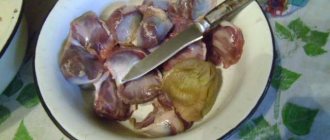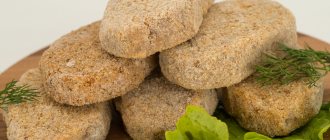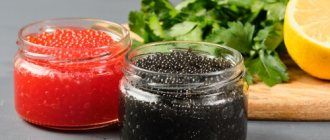The presence of a variety of seafood on the menu provides a person with everything necessary for full-fledged life.
Therefore, you need to know not only how to cook, but also how to peel squid. Do you like to cook squid?
- Yes 92%, 2454 votes
2454 votes 92%2454 votes - 92% of all votes
- No 8%, 209 votes
209 votes 8%
209 votes - 8% of all votes
Total votes: 2663
14.05.2020
- Yes 92%, 2454 votes
2454 votes 92%2454 votes - 92% of all votes
- No 8%, 209 votes
209 votes 8%
209 votes - 8% of all votes
Total votes: 2663
14.05.2020
×
You or from your IP have already voted.
What are the benefits of squid?
Seafood is rich in salts and minerals, including rare ones, the content of which in animal and plant foods is small and cannot meet the needs of the human body. Research from various scientific communities says that residents of coastal areas, whose diet is rich in fish and other seafood, get sick less often and have a more stable immune system.
The meat of squid, which is a type of cephalopod, consists of a large number of different proteins. It contains many important microelements that improve brain function and normalize digestion.
What are the benefits of squid?
The data on the content of nutrients in squid and other seafood is interesting; any ingredient from a healthy food recipe can envy them:
| Product/composition | Squirrels | Fats | Carbohydrates | Calorie content |
| Fresh squid | 19 | 2,5 | 1,82 | 98 |
| Scallop | 17 | 2 | 3 | 92 |
| Fresh shrimp | 22 | 1 | 0 | 97 |
| Crab meat | 6 | 1 | 10 | 73 |
The content of substances is indicated as a percentage of weight, and calorie content in kcal/100 g.
A diet that includes squid dishes is recommended for strengthening male power. The content and composition of proteins in them helps to improve potency lost with age or due to disease. Women rightfully consider squid a product that restores freshness to the skin, but you should be careful when consuming their meat during pregnancy and breastfeeding.
Dishes with squid
Tomato soup with squid
Prepared like a classic seafood soup. Chop the shallots, garlic, thyme, fry everything in a frying pan in oil. Add cleaned squid, then a quarter glass of white wine, evaporate, pour vegetable or fish broth over everything. Peel the tomatoes, chop to a puree consistency and add to the total mass. Let it boil, cook for 2 minutes, add butter, salt, pepper, sugar.
Ingredients for tomato soup with squid
Tomato soup with squid
Breaded squid rings
Cut the cleaned squid into rings, add salt and pepper. Separately prepare the standard ingredients for breading: egg, flour, crackers. Dip the squid in flour, then in a well-beaten egg, again in flour and carefully coat in breadcrumbs.
Place the breaded rings in the freezer for 10 minutes - this will “set the shape” and make them easier to fry. Heat the oil to 160 degrees, lower the squid rings into the oil for 1.5 minutes. Place on a napkin to drain excess oil. Serve with any sauces: tartar, adjika, garlic, sour cream or hot sauce.
Ingredients for breaded malmars
Breaded squid rings
Stuffed squid
Pre-clean the squid. Wrap the potatoes in foil and bake in the oven, then cut out the core, mix with butter and soft cheese, add finely chopped poached green onions. Stuff the cleaned squid with the filling, pierce it with a skewer, and fry in a frying pan for 40 seconds until golden brown. Place on parchment and place in the oven for 5 minutes at 180 degrees. Serve the appetizer with green butter and cherry tomatoes.
Ingredients for stuffed squid
Stuffed squid
How to defrost squid correctly
The technology for preparing deep-frozen products is designed to heat them to high temperatures. Some products are used in the cooking process without thawing, but with squid you have to do something different. Squids are usually frozen unpeeled, and to remove the skin, as well as for ease of cutting, they are first thawed.
The best way is to keep the carcasses at a temperature of +3 to +12°C. At home, these conditions correspond to the temperature in the general compartment of the refrigerator. The shellfish are removed from the packaging, placed in a bowl or flat container and placed on the top free shelf.
How to defrost squid correctly
At a temperature normal for a kitchen room (+25...+30°C), the squids are thawed by filling a bowl with clean cold water. This takes up to 3 hours, depending on the size of the carcasses and their storage temperature. Water can be changed and used warm, up to +40°C, this speeds up the process somewhat.
It is strictly undesirable to defrost shellfish in a microwave oven or using hot water. The pulp becomes rough, loses elasticity and loses nutrients. It is not recommended to prepare squid thawed in this way for human consumption.
What to look for when buying frozen squid meat
The main stage on which all subsequent ones depend is the choice of squid meat. In order not to make a mistake and not spoil your dinner, it is important to pay attention to the following factors:
- Freezing and storage conditions
If squid meat stored in industrial packaging is tightly stuck together and frozen to each other, then you should not buy it. Ice and dark spots on the surface of the skin indicate that the carcasses are of poor quality. This means they have been frozen more than once.
- Carcass color and size
Choose smaller carcasses. The meat of young animals is tastier. Pay attention to how the squid's skin and tentacles look. They should be white or cream in color. Pink, yellow and lilac indicate that the product has been re-frozen, which means the meat will be tough and tasteless.
- Smell
Fresh squid meat smells good. It does not emit a strong ammonia or rotten smell. If the meat exudes a stench, then you cannot buy such products.
- Catch time and expiration date
Frozen shellfish can be stored for no more than 2 years; it is better to choose squid caught in July or August.
How to clean squid from film
Removing thin skin from carcasses is a mandatory process in preparing them for use. The technique of removing the film from already boiled shellfish is simple, but it is considered not the best, since squid with this method of preparation does not turn out as tasty.
Cold method
This option is convenient for cleaning fresh squid, but is also suitable for carcasses that were frozen very carefully, in compliance with technological requirements.
You can peel the squid from the film by grabbing any edge of the skin (you can deliberately cut it slightly), holding it between a knife blade and your thumb, and with a sharp movement pull it off the carcass, like a stocking. If the film yields in small pieces, remove it in parts, otherwise they resort to a more radical method.
Hot method
It’s easy to clean the squid from the film by placing the carcasses in a colander and briefly dipping them into boiling water. Leave it for no longer than 10 seconds, after which it is immediately immersed in cold, or best of all, ice water. The film should shrink, after which it can be easily removed simply with your fingers or using a knife.
Cleaning cooked squid
It is permissible to resort to this method only in cases where squid is further prepared in spicy or salty marinades. The mollusks are thawed and gutted, the tentacles are separated from the head, and the entrails and chordal plate are removed from the body.
Cleaning cooked squid
The remaining edible parts are dipped in salted boiling water or a decoction of roots and spices, cooked according to the recipe, but, as a rule, no longer than 3 minutes. Cooled carcasses are cleaned by rubbing the surface with force with your fingertips; still hot squids are cleaned with a soft brush. The skin is rolled into balls, after which it is first shaken off, and the completely processed carcass is washed.
Cold method
When frozen squids are completely thawed, you can use the cold method of peeling them. Here's how you can use it to clean squid:
- Carefully pry off the skin from the side of the circular hole. To do this, you can use a sharp knife or the edge of your nail.
- Carefully remove it towards the fins. The carcass must be held tightly against the cutting board so that the squid can be processed in one go.
- It is advisable, in order to make processing easier, not to defrost the carcass completely. Let it remain slightly frozen.
- Repeat this manipulation several times until all the skin is completely removed.
- Then simply rinse the squid under running water.
- If you need to keep the carcass intact for further stuffing, you need to carefully turn the seafood inside out and clean all the insides.
- After this, carefully pull out the chord and other solid parts.
- If there is no need to leave the carcass whole, it is further cut up. It is important that the cleaning is completely completed at this point, since it will be almost impossible to peel off the skin after cutting.
Further processing depends on the cooking method.
How to clean fresh squid
Although this product is quite problematic to purchase in most regions, the technology is worth presenting at least in general terms. The squid is taken with both hands, one by the base of the head, the other by the body itself (hood). With one sharp, but not too strong movement, the head and entrails are pulled out of the hood.
The tentacles are cut off from the head, and the entrails and chitinous rod are removed from the body. The edible parts are rinsed, then the cold (stocking) method is used to remove the film.
Mini-cooking cleansing
If in hot summer weather the squids managed to melt on the way from the store to the house, then the question arises of how to properly clean them in this case. Boil water in a saucepan with the addition of spices, salt, bay leaves, etc. as desired.
The squid is cut lengthwise and the insides are removed. Next, rinse with running water and immerse in boiling water. Cook for no more than 3 minutes, then quickly remove. The film usually separates on its own and remains in the water. Here's how to boil and clean squid at the same time.
Cleaning whole frozen carcasses
Small suppliers often freeze squid in this form. This is sometimes done to save on cutting costs, but it is also believed that squid in this form retains more nutrients when frozen. The carcasses are thawed using one of the above methods, not washed and separated into parts, like fresh shellfish.
Cleaning whole frozen carcasses
Next they clean, first trying to use the cold method, and if this is not successful, they move on to blanching and further cleaning.
Removing the film
Since you need to peel seafood not only from the skin, but also to remove all the thin transparent films, you need to know exactly how to do this.
The fact is that under the upper translucent skin there is a film hidden, which may not be noticed during cleaning. If left, it may also coagulate during cooking. Therefore, it is necessary:
- Using a sharp knife blade or the edge of a nail, pry the edge from the entrance to the squid carcass. A thin film will separate.
- You shouldn’t immediately try to separate it from the meat; it’s better to put your finger under it, trying to move it as deep as possible.
- Thus, moving the film away from the main part, carefully remove it over the entire area.
- If you tear it off, it will come off in strips and this process will take a lot of time.
- If you leave it on the carcass, it will be wrong, as it will give the meat a tougher structure.
Master class from Ilya Lazerson
A well-known media chef offers a simple and effective way to clean gutted, defrosted squid:
- The carcasses are not rinsed; they are placed in a spacious bowl and filled with freshly boiled water. Quickly stir the squid with a spoon and remove to a dish.
- Most of the skin will be washed off with boiling water, which is why it takes on a brick tint; the remaining fragments can be easily peeled off with your fingers. If the carcasses are not intended for cutting into rings, they are cut on one side and the remaining entrails and chord are removed.
This method is part of the squid recipe. According to the advice of the famous chef, they are not boiled, but poured with fresh boiling water twice for several minutes. This allows you to bring the pulp to readiness, guaranteed to leave it soft and juicy.
The fastest way to clean squid (if time is short)
If guests are already on the way and you need to quickly figure something out, then a salad with squid or other dishes with this shellfish are ideal. First of all, because it cooks quickly, and food with it always looks unusual.
So, if time is short, then you don’t even have to defrost the squid meat. Simply place the carcasses in a bowl, add boiling water and leave to cool for 2 minutes. Then place the meat under running cold water. The skin will wrinkle and it will not be difficult to remove it.
The next stage is gutting. There is no way to do this without removing the entrails and chord.
Secrets and tips for choosing and cooking squid
The condition of frozen food is usually assessed by appearance. Squids should be without clearly visible damage to the body and broken tentacles, if the carcasses are not gutted. Peeled, high-quality shellfish are always white, while unprocessed shellfish are brick-pink.
Secrets and tips for choosing and cooking squid
Good quality squid should not be covered with ice; at most it may be a thin layer of frost if the carcasses are in large and already opened packages for bulk sale. General recommendations for preparation can be gleaned from the details of their cleaning already described. Prolonged heating is most undesirable for the delicate tissue of mollusks.
Recipes may indicate different durations of heat treatment, but generally it does not exceed 3–4 minutes.
Methods of cooking squid, in addition to the traditional one, also include the following gentle methods:
- The thawed body of the cleaned squid is put on a small slotted spoon and immersed in boiling salt water for 10 seconds. Take it out, wait for it to boil again, and blanch the squid again for the same amount of time. Repeat 5–8 times in total, depending on the size and desired degree of readiness.
- Cleaned squid can be cooked without defrosting. They are completely immersed in boiling water, boiled for exactly a minute and the heating is turned off. Keep the shellfish in cooling water for 4 minutes and place on a dish.
It is convenient to fry squid after processing it using the first of the proposed methods; the only thing that must be taken into account is the total heating duration. For this reason, shellfish are blanched quickly, only 3 times.
Secrets from the boss
- The first rule for cleaning a shellfish is to create a temperature difference for it . For example, to clean the carcass of a frozen squid, you need to pour boiling water over it, while a freshly boiled one needs to be poured with ice water.
Now you know how to clean frozen squid. It's time to learn how to cook them.
- Only completely thawed carcasses can be cooked. To defrost the squid, it is recommended to fill it with salted cold water.
- The first rule of cooking shellfish is not to expose it to shock temperatures . If you boil, the water should not boil. Simmer – the contents of the pan should not boil. If you cook the carcass for more than 2 minutes, it will turn into a rubber eraser. As soon as the meat turns white, it must be immediately removed from the boiling water.
- In case the meat is still overcooked in boiling water , the cooks have a secret: continue cooking for another 40-50 minutes. It won’t become completely soft, but you can still chew it.
- Clams are boiled for salads, but you can stew them in sauces or wine, fry them in a frying pan or grill and bake them.
- Carcasses and tentacles are ideal for stuffing . They can be filled with anything: cheese, rice, mushrooms, nuts, tomatoes.
Which squid is better to buy: peeled or not?
If you want to buy a “no-hassle” product, buy cleaned squid. But if you need tasty and healthy seafood, choose only unpeeled carcasses.
There are about ten types of squid on the Russian seafood market, but only a few of them deserve attention. Komandorsky squid is considered one of the best. Appearance: Uncleaned carcass. Length: 35 cm. Skin color: gray with purple, uneven. Supplier: Russia.
Patagonian squid is also highly prized. Appearance: unpeeled carcass 2-23 cm long. Skin color: red-brown, brown, uneven. Supplier: Spain.
In general, the color of squid depends on the type of cephalopod and can be grayish-white (but not grey), pink, blue, or purple.
Is it possible to remove the film from defrosted meat?
There are situations when squids come home already defrosted. Summer heat and unforeseen travel delays should not prevent you from preparing a delicious dish. To do this, you need to perform the following algorithm.
- Prepare a pan of boiling water and seasonings (salt, bay leaf and pepper).
- Cut the carcass lengthwise and remove the entrails.
- Rinse the meat well.
- Boil the carcasses in seasoned boiling water for 2-3 minutes.
- Remove the squid. In this case, the films will remain in the water, calving themselves.
Should I clean before or after cooking?
When preparing dishes, you need to choose only high-quality freshly caught seafood, which is easy to clean and has a pleasant and delicate taste.
Fresh product is difficult to find in regular grocery stores; most of the goods are presented frozen.
- unprocessed squid with skin and entrails, but no head or tentacles
- cleaned and processed shellfish
A product that the manufacturer has fully prepared for the buyer is certainly more attractive and has a lot of advantages, but experts recommend paying attention to the disadvantages:
- rubbery and tough meat structure;
- altered taste characteristics;
- lack of large amounts of vitamins and minerals.
A product that has been frozen several times is of low quality, and the prepared dish will certainly disappoint with its taste characteristics.
Signs of low-quality squid:
- stuck together carcasses;
- meat color – red or purple;
- big size;
- unnatural colors;
- specific smell.
Cooking such a product will give a bitter taste to the dish, the meat will be hard and dry. Experts do not recommend eating squid, which look stale and have an unpleasant odor.
High quality frozen seafood should be easy to separate from each other, have white flesh, be small in size and have a pleasant smell. Long-term storage of peeled squid leads to changes in taste and loss of valuable nutrients.
Removing the transparent film before cooking will preserve the volume of the carcass and avoid the formation of a rubbery meat structure. During cooking, unpeeled squids significantly reduce their size and become hard. Tough and hard meat will definitely spoil the quality of the prepared dish and disappoint invited guests and family members.











